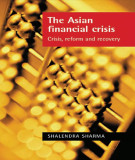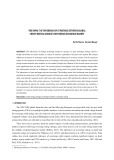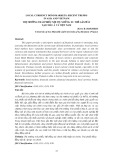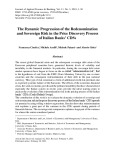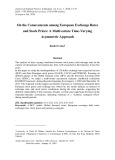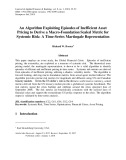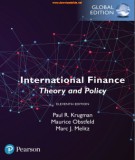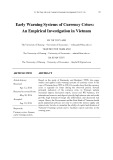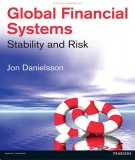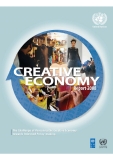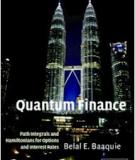
Currency crisis
-
Ebook "The Asian financial crisis: Crisis, reform and recovery" provides answers to all the above questions and more, and gives a comprehensive account of how the international economic order operates, examines its strengths and weaknesses, and what needs to be done to fix it.
 409p
409p  tuongnhuoclan
tuongnhuoclan
 28-11-2023
28-11-2023
 6
6
 5
5
 Download
Download
-
Part 2 book "Economics of developing countries" includes content: Balance sheet effect of currency crisis: Evidence from indonesia, the economics of upgrading to innovative treatment technologies in the fight against HIV/AIDS; the effect of democratization on growth of developing countries.
 211p
211p  oursky01
oursky01
 24-07-2023
24-07-2023
 3
3
 3
3
 Download
Download
-
Continued part 1, part 2 of ebook "International economics: Theory and policy" provide readers with content including: exchange rates and open-economy macroeconomics; national income accounting and the balance of payments; money, interest rates, and exchange rates; international macroeconomic policy; optimum currency areas and the European experience; developing countries - growth, crisis, and reform;...
 413p
413p  dieptieuung
dieptieuung
 19-07-2023
19-07-2023
 9
9
 3
3
 Download
Download
-
The behaviour of foreign exchange market in reaction to split sovereign ratings, which is hardly mentioned on recent studies, is a topic of concern, especially in the post-crisis period. We analyse difference of opinion in sovereign credit ratings and their influence on currency market. The first question relates to the response of exchange rates to sovereign credit rating changes.
 19p
19p  vihassoplattner
vihassoplattner
 07-01-2022
07-01-2022
 15
15
 0
0
 Download
Download
-
This paper provides a descriptive analysis of financial systems in emerging Asia, assessing the dimensions of the current state of bond markets. In particular, local currency bond markets have expanded dramatically since governments took steps to end the currency and maturity mismatches that savaged borrowers in the region’s financial crisis nearly twenty years ago.
 22p
22p  viuchinaga2711
viuchinaga2711
 21-10-2021
21-10-2021
 15
15
 0
0
 Download
Download
-
The recent global financial crisis and the subsequent sovereign debt crisis of the Eurozone peripheral countries have generated historic levels of volatility and instability in the financial markets. In particular, during the sovereign debt crisis market operators have begun to focus on the so-called “redenomination risk”, that is the hypothesis of exit from the EMU (Euro Monetary Union) by one or more countries and the consequent redenomination of their debt in the past national currency.
 30p
30p  nat_qb73
nat_qb73
 21-02-2021
21-02-2021
 15
15
 2
2
 Download
Download
-
This study investigates (i) the impact of first- and second-moment exchange rate exposure on individual firm value and the stock return volatility underlying exchange rate fluctuation, (ii) the time-varying exchange rate exposure following the 1997 Asian financial turmoil and the global financial crisis which started in 2007. We find a high percentage of exposed firms before the two crises but if this percentage decreases dramatically after, the exposure level is much larger. The two crises affect also the asymmetric profile of the firms and volatilities.
 23p
23p  covid19
covid19
 19-04-2020
19-04-2020
 20
20
 2
2
 Download
Download
-
Economic performance evaluation problem consists many criteria and sub criteria. Therefore it is a kind of multi-criteria decision making (MCDM) problem. It is very important for a country to monitor performance parameters in order to ensure that appropriate and timely decisions and plans can be made. Suitable performance measures can ensure that governments adopt a long-term perspective and allocate the country’s resources to the most effective activities. Fragile five (F5) countries namely Brazil, Turkey, India, Indonesia and South Africa have large and fast growing economies.
 17p
17p  trinhthamhodang2
trinhthamhodang2
 21-01-2020
21-01-2020
 57
57
 0
0
 Download
Download
-
The analysis of time varying correlation between stock prices and exchange rates in the context of international investments has been well researched in the literature in last few years.
 27p
27p  trinhthamhodang2
trinhthamhodang2
 21-01-2020
21-01-2020
 16
16
 4
4
 Download
Download
-
This paper employs an event study, the Global Financial Crisis. Episodes of inefficient pricing, the externality, are exploited as a measure of systemic risk. The theoretical asset pricing model, the martingale representation, is shown to be a valid algorithm to identify episodes of efficient and inefficient pricing in time series. Systemic risk metrics are derived from episodes of inefficient pricing, utilizing a shadow volatility metric. The algorithm is forward looking, deriving macro-foundation metrics from actual agent market behavior.
 18p
18p  trinhthamhodang2
trinhthamhodang2
 19-01-2020
19-01-2020
 35
35
 1
1
 Download
Download
-
(BQ) Continued part 1, part 2 of document Theory and policy of international finance (Eleventh edition) has contents: International monetary systems - an historical overview, optimum currency areas and the euro; developing countries - growth, crisis, and reform mathematical postscript,... and other contents. Invite you to refer.
 205p
205p  thuongdanguyetan04
thuongdanguyetan04
 25-07-2019
25-07-2019
 33
33
 2
2
 Download
Download
-
Based on the study of Kaminsky and Reinhart (1999), this paper studies and applies early warning systems of currency crises to the case of Vietnam from 1996 to 2014. Its results show that the currency crisis is signaled six times during the observed period.
 20p
20p  danhnguyentuongvi27
danhnguyentuongvi27
 18-12-2018
18-12-2018
 21
21
 0
0
 Download
Download
-
(BQ) Part 2 book "Global financial systems" has contents: Currency crisis models, financial regulations, bailouts, dangerous financial instruments, failures in risk management and regulations before the crisis, the ongoing crisis: 2007–2009 phase, ongoing developments in financial regulation, sovereign debt crises
 210p
210p  bautroibinhyen22
bautroibinhyen22
 22-03-2017
22-03-2017
 40
40
 1
1
 Download
Download
-
Based on the analysis, a number of conclusions emerge. The new member states stand to gain substantially from the adoption of the euro. The lower interest rate in the Euro Area will promote catch up growth, while financial stability will be enhanced due to the elimination of exchange rate risk to the euro. Being a member of the Euro Area will make the financing of the large current account deficits easier and less costly. Furthermore it will eliminate the risk of a currency crisis following sharp reversals of capital flows. ...
 357p
357p  hoangphiyeah1tv
hoangphiyeah1tv
 18-04-2013
18-04-2013
 64
64
 5
5
 Download
Download
-
Financial markets have undergone tremendous growth and dramatic changes in the past two decades, with the volume of daily trading in currency markets hitting over a trillion US dollars and hundreds of billions of dollars in bond and stock markets. Deregulation and globalization have led to large-scale capital flows; this has raised new problems for finance as well as has further spurred competition among banks and financial institutions.
 334p
334p  haiduong_1
haiduong_1
 03-04-2013
03-04-2013
 59
59
 9
9
 Download
Download
-
Where a sub-fund may have investment exposure to Europe in the context of its investment objective and strategy, in light of the fiscal conditions and concerns on sovereign debt of certain European countries, such a sub-fund may be subject to a number of risks arising from a potential crisis in Europe.
 64p
64p  dangsuynghi
dangsuynghi
 15-03-2013
15-03-2013
 44
44
 7
7
 Download
Download
-
Europe's strength lies in the interconnection of our economies. The single market and the common currency have driven this forward, and the integrated economic policy making at the European level through the European semester is now drawing our economies together as never before. However, the crisis has shown that the single market for financial services can only deliver financial stability, economic growth and jobs if it is matched with a strong single regulatory and supervisory authority at EU level.
 24p
24p  lenh_hoi_xung
lenh_hoi_xung
 01-03-2013
01-03-2013
 51
51
 7
7
 Download
Download
-
Indeed, turning back the clock to that period, we see that the credit booms in Asian economies displayed much the same regularity.6 In the run-up to the Asian crisis, direct and indirect cross-border credit grew to account for a combined share of roughly one third of the total credit to non-banks in Indonesia and Thailand, and more than a quarter in Korea (Graph 2). Indonesian firms relied heavily on direct cross-border credit, especially in 1996–97 (albeit not to the same extent as borrowers in Ireland more recently).
 4p
4p  enter1cai
enter1cai
 12-01-2013
12-01-2013
 38
38
 1
1
 Download
Download
-
In other European countries such as Hungary and Latvia, this indirect cross-border credit was even more important in the run-up to the crisis. Much of this reflected the (interoffice) channelling of funds by foreign banks outside these countries to their subsidiaries in these countries (left-hand panels, dashed brown line), which in turn extended foreign currency loans to residents (right-hand panels).
 14p
14p  enter1cai
enter1cai
 12-01-2013
12-01-2013
 40
40
 2
2
 Download
Download
-
Finally, international (foreign currency) credit can also put upward pressure on the real exchange rate, as borrowers exchange foreign for domestic currency for the purchase of domestic goods or assets. With a fixed exchange rate (or within a currency area), real exchange rate appreciation can take the form of relatively rapid inflation. For a country with an independent currency, real exchange rate appreciation can result from either nominal appreciation or relatively rapid inflation.
 11p
11p  enter1cai
enter1cai
 12-01-2013
12-01-2013
 48
48
 2
2
 Download
Download
CHỦ ĐỀ BẠN MUỐN TÌM









